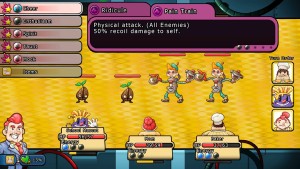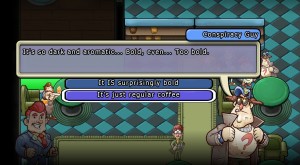If Earthbound never released on the Virtual Console, Citizens of Earth would be the closest approximation to that experience. Eden Industries’ title on the Wii U and 3DS is full of funny dialogue, clever combat mechanics, and a old-school open-world gameplay. Eden adds their own flavor to turn-based jRPG battles, keeping players from simply mashing A to progress through the game. I cannot say Eden’s strategy lasts throughout the entire game, but the combat is definitely a blast for the first half.
The plot is nothing serious. Some force is driving people mad and creating monsters (such as a cat-cactus hybrid and a honey-craving bear who is himself made of honey). Your job as the Vice-President of the World is to recruit citizens and get to the bottom of this (lest he lose any voters in the next election). The story always remained light and humorous throughout the entire adventure. However, this did cause problems later on, as I never felt the story escalate, so I wasn’t sure of my progress.
Recruiting as many citizens as possible is a key element in the game. Different citizens yield different advantages both in battle and on the field. For example, the car salesman will lend you his car to speed down roads, and the Gardner can prune different bramble patches blocking items or shortcuts or items. While these benefits can net you a few extra items, they also provide multiple routes to progress through the game. Since there is rarely an indication as to which recruits you need, you’re better off just grabbing as many as you can.
If you’ve ever played the SNES Classic, Earthbound, you’ll notice the similarity between the two systems. During the first half of the game, fighting enemies was always an interesting challenge. The citizens you’ve recruited can have advantages or disadvantages against certain foes, so you always have to plan accordingly. If you get caught with a bad combination of enemies or allies, you can select the redo option to restart the fight with a different combination of citizens.
Both enemies and allies attack using an energy system. Attacks can either gain or drain energy orbs, so you’ll have to keep tabs on everyone’s actions. You can also gain orbs by sneaking up an enemies or by hitting their weakness. Conversely, you lose orbs when an enemy catches you from behind, or when you hit with an attack the enemy is strong against. This ensures you are especially careful with your attacks, even if you are vastly stronger than your enemy.
You’ll get plenty of practice against enemies, as avoiding them is easier said than done. Your encounter hit-box extends to all four characters in your party, which doesn’t leave you room to maneuver. If you don’t go straight for an enemy, more likely than not, they will get the jump on you and cost you an extra energy. Enemies can also tend to come at you one at a time, leading to multiple battles, which can become tedious and annoying. Once you defeat the area boss, all of the enemies will turn tail and run. Charging at them with their backs turn can be good if you want to quickly level up some of your lesser-used citizens.
I hope you are prepared to get lost wondering the world around you. There are objective markers, but they only give you a vague understanding of which direction you need to travel. Often times, you will reach a dead end, and will need to retrace your steps. Given that enemies respawn each time you enter a room, and you will find yourself accidentally grinding level after level. Given that there are one so few ways to travel quickly, making a wrong turn can be very costly. Don’t think your objective screen will help you at all. Nearly all of the objectives are a variant of “Go to X,” or “Go do Y,” leaving you to figure out the rest, or simply wonder around until you come across your objective.
Each citizen have unique items they can equip that can buff and rebuff certain stats, adding another layer of strategy in the game. There are some items that only grant buffs, such as health refill on critical, or regen on critical, which made all other items an after thought, and made my battles far easier.
The game’s difficulty can be adjusted by talking to the school mascot, and often times, you will find yourself turning up the dial. By level 40, nearly all of the enemies were but a nuisance. Combined with the inability to avoid fights and narrow paths near the end of the game, the final chapters feel more drawn out than necessary.
If you own both a Wii U and a 3DS, you are better off getting the 3DS version. Alex Schramke, who reviewed the 3DS version, only experienced a few cosmetic problems (battle music dropping out). I on the other hand, was forced to reset the game at least a dozen times due to getting caught in geometry, the game failing to read my inputs, or the game freezing up completely. These problems only became frequent in the second half of the title, so beware. Hopefully, Eden will release a patch update to fix these issues. In the meantime, save often, and in different save files.
Glitches aside, Eden Industries have created a title that jRPG enthusiasts would be interested in adding to their collection. The battle system is not impenetrable for newcomers, but the sheer amount of battles may be a put off for some. Characters are fun and colorful, and Eden’s spin on turn-based combat is a nice attempt that I wish stayed significant throughout the entire title. Citizens of Earth is $11.99 on both the Wii U and 3DS, so if you want it purchase the title, so either go with the 3DS title, or wait for any patches Eden may release.
PN Review: Citizens of Earth (Wii U)
Glitchy, but still fun.
Fun, but filled with bugs, and falls apart on the second half.





January 24, 2015
it did not get as high of a review as I had hoped but I think I will still give it a try. I have been looking forward to this game since I first read about it.
January 24, 2015
I agree, I have been a huge Earthbound fan since I first laid eyes on it in Nintendo Power and I’ve been waiting for Citizens of Earth in the same way. I do appreciate that PNM reviewed both the Wii U and 3DS versions, as I have been waiting to purchase until I got a decent comparison.
Verdict 3DS! To the eShop!